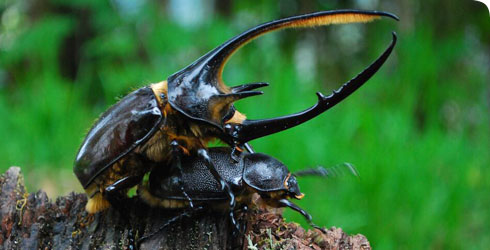Behaviour
The males use their horns in combats over access to females or breeding sites. The beetles will try to prise each other off a tree trunk or log and then carry or flip their opponents away with their horns.
Usually the largest males are the victors, but smaller males are sometimes able to sneak past battling pairs of big males.
Successful males will mate with the female and fertilize her eggs.
The females lay eggs in decomposing tree trunks - especially those that are left standing - where the larvae develop feeding on the decaying wood in tree hollows from the ground up to the canopy. They can be quite numerous in old tree cavities.
They have been recorded from several tree species including some in the families Euphorbiaceae, Lauraceae and Urticaceae,
The larvae probably develop over the course of 2 or more years, going through 3 larval instars before pupating in a large cocoon made from the substrate.
The larval stage is the ecologically important one because the larvae are decomposers - they facilitate the breakdown of organic matter and are therefore important nutrient recyclers.
Adults live for a few months, but can be kept in captivity for up to a year, The comparatively short lived adults are only concerned with finding mates and reproducing. They eat sweet and sticky tree sap, fermenting fruit and sugar cane.
The beetles are nocturnal and fly around noisily at night. They can be attracted to artificial lights, like many other rhinoceros beetles, moths and other insects. Entomologists routinely use very bright mercury vapour light bulbs to attract insects for study.
